WatchTime Wednesday: The History of the Rolex Datejust
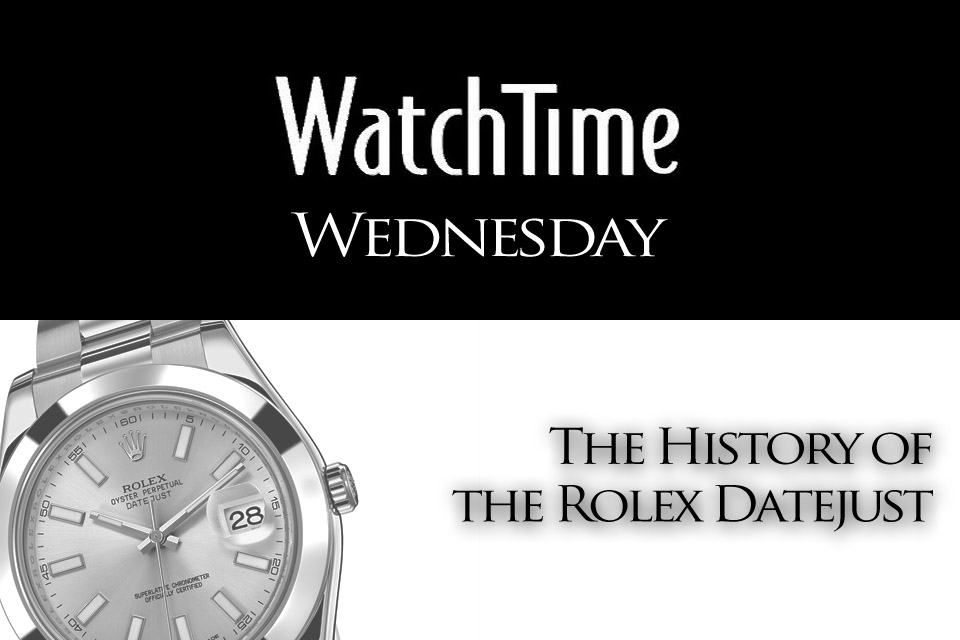
The Rolex Datejust is without a doubt one of the most emblematic watches of the Rolex Collection. Maybe more than the sporty Submariner, that is of course a great piece of history. But the Datejust is the essence of a Rolex: simple, reliable, rock-solid, very well made and designed as a Rolex should be in the collective psyche. Our friends of WatchTime wrote a comprehensive history of this icon that needed to be shared with you here.
Rolex is considered as a pioneer of numerous innovations. Back in 1945, the Geneva watch manufacturer, just in time for its 40th anniversary, launched the Oyster Perpetual Datejust. As simple as it can be, the quick changing date is a milestone in the development of watches.

One, two, three hands – and nothing more! This was manufacturers’ motto for decades. Whether we’re talking about pocket watches or wristwatches, the industry had for years offered only 3 hands to its clients – except chronographs and some rare and complicated calendar watches. But in 1945, Rolex presented the first wristwatch with a date display and a quick date mechanisms.
The history of the world’s most famous watch manufacture begins in Kulmbach, a Bavarian city where Hans Wilsdorf, founder of Rolex, came to the world in 1881. At the age of 24, Wilsdorf went to England, just after he completed a commercial apprenticeship in Germany and worked in Switzerland in the watch industry. He started early to be into watches, although almost all brands were manufacturing only pocket watches. Something that Wilsdorf wasn’t convinced about.
1905: Wilsdorf & Davis, the origin of a collaboration that led to the world’s largest luxury brand
After two years in London, Wilsdorf had the strong conviction that wristwatches were a highly marketable product. Together with his brother-in-law Alfred Davis, he founded Wilsdorf & Davis. The two partners shared the business – Davis was responsible of the manufacturing, while Wilsdorf purchased the movements. Wilsdorf and Davis’ main business at the time was importing Hermann Aegler’s Swiss movements to England and placing them in quality watch cases made by Dennison and others.
However, this newly created watch brand needed a name suitable for the commercialization and internationally recognizable. In 1908, the legend began as Wilsdorf invented the name Rolex (the name is a pure invention and no confirmed theory can explain his inspiration). From 1913, Rolex had the exclusivity of the Bieler Aegler SA movements in UK, and even if still protected by Rolex, this name is not used anymore since the 1930s, as the company had been absorbed by Rolex. Because of the first World War, Wilsdorf moved the company to Bienne, Switzerland. Montres Rolex SA was officially registered on January 17, 1920. One of the key features Rolex was and still is the accuracy, something that can be found back in 1910 with proofs of a chronometer testing – today almost all the watches made by Rolex are chronometer certified by the COSC.

The long life of an icon
One of the first innovations of Rolex, which had a tremendous impact on the whole market, was the waterproof case, named Oyster Case – a case that was as closed as an oyster. This name and concept is still used nowadays, as well as the specific notched caseback, which can be opened only with a special tool. In 1931, Rolex launched the Oyster Perpetual that came with an automatic movement, wounded by a rotating mass. For more practicality Hans Wilsdorf integrated a new, simple but important feature: a display of the date. Under the reference 4467, the Rolex Datejust was born. And it was close to the actual edition: a 3-hand gold watch with a date aperture at 3 o’clock that changed automatically at midnight. Thanks to an intermediate gears and a spring mechanism, the date disc was able to make an instant jump at midnight. The date was just, all the time.
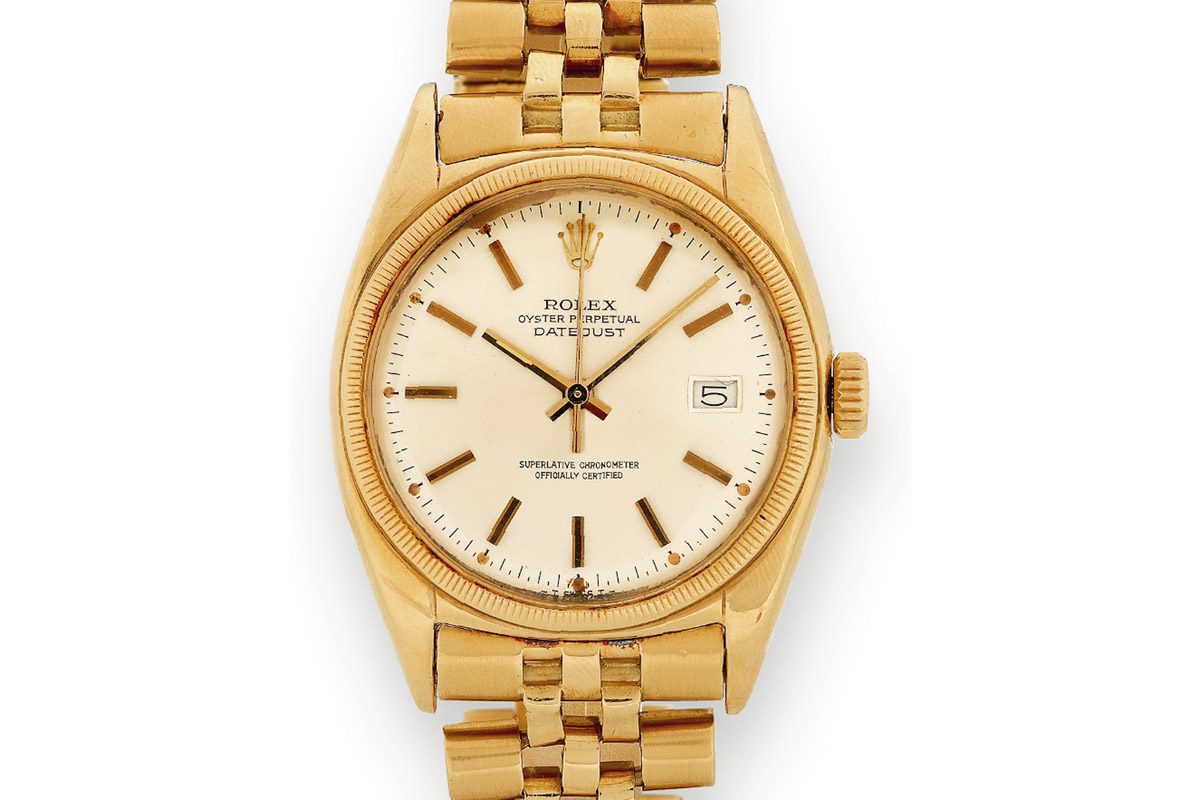
At the beginning, one of the main characteristic of the Rolex Datejust was missing: the date magnifier. It is only in 1954, after nine years of production, that Rolex introduced the so-called Cyclops lens. At the beginning only yellow gold was available. Then Rolex decided to introduce rose gold, steel or two-tone editions. The bezel was also slightly different at that time as, instead of the fluted design, Rolex was using a coin-style bezel.
The watch was a spontaneous success – the automatic winding, the high accuracy and date display made the Oyster Datejust an excellent and practical watch. The high water resistance was achieved with a screwed caseback that was so-called bubble-back, with its rounded shape – dictated by the shape of the rotor. The Datejust also introduced the Jubilee, a new type of gold bracelet that still exists nowadays in Rolex’s collection.
In 1945, the Datejust was using the Calibre 710, replaced after by the Calibre 730, which uses 17 jewels. However, these movements, even if reliable and solid, are very difficult to service, as the spare parts are nearly impossible to find. Even Rolex can no longer repair these historical watch models. The prices for such watches can achieve very high values ??- during auctions, count on an average 10.000Eur.

In 1957, the design of the Datejust changed. Due to its new Calibre 1065, the back was now flat and the the magnifier appeared too. The price was also quite impressive (1950s standards of course): A two-tone Datejust with Jubilee bracelet was priced at 360USD.
In 1965, the caliber changed one more time with the introduction of the very famous Calibre 1570. From 1972, the time of this chronometer could be precisely adjusted thanks to a hacking second mechanism. And two years after, Rolex introduced the sapphire crystal.
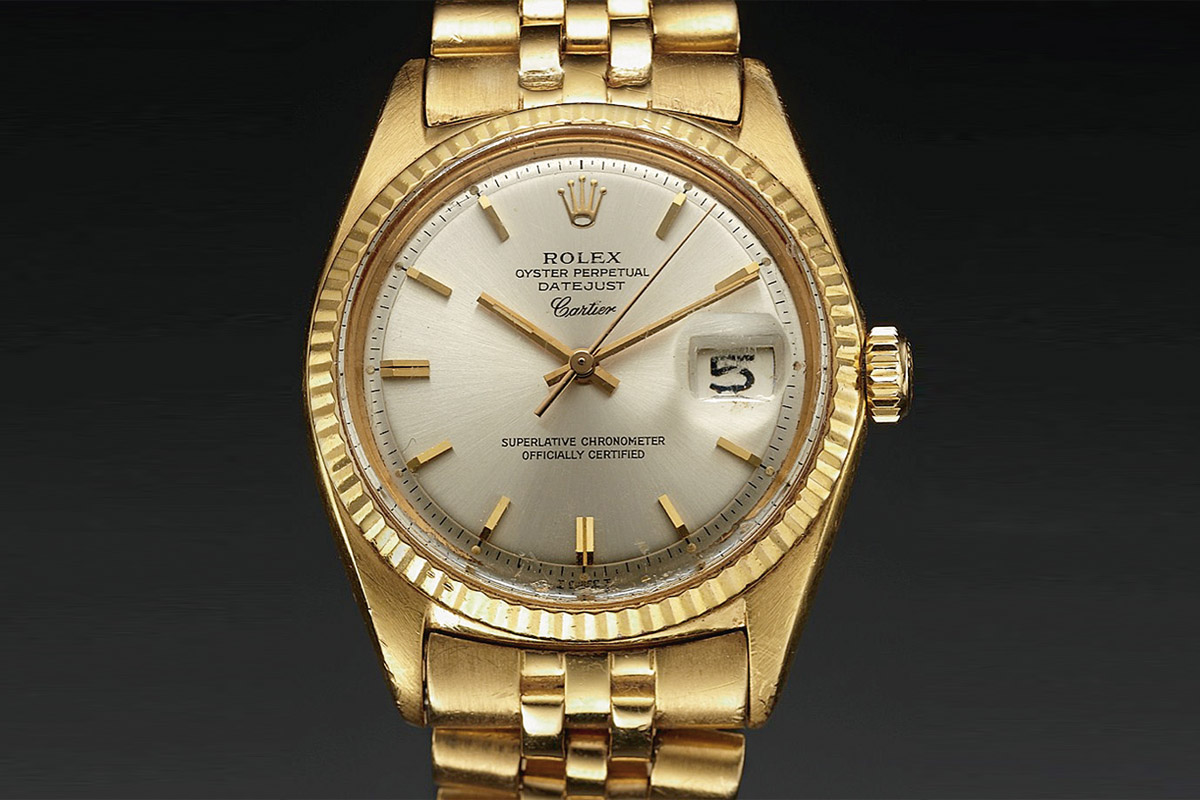
In 1962, 16 watch companies, all shareholders of the Centre Electronique Horloger in Neuchâtel, jointly developed the first quartz caliber, the Beta 21. With the feeling of being far above the rest of the industry, Rolexdidn’t participate but later improved the concept of the Quartz in its own laboratory and creates the OysterQuartz. The Rolex Datejust OysterQuartz ref. 17000 was introduced in the 1977 catalog, equipped with an in-house quartz movement put proved not to be very successful. Its success is however quite impressive now, with prices that can reach, depending on the condition, between 2.500Eur and 10.000Eur, even if its integrated bracelet is not really up-to-date.
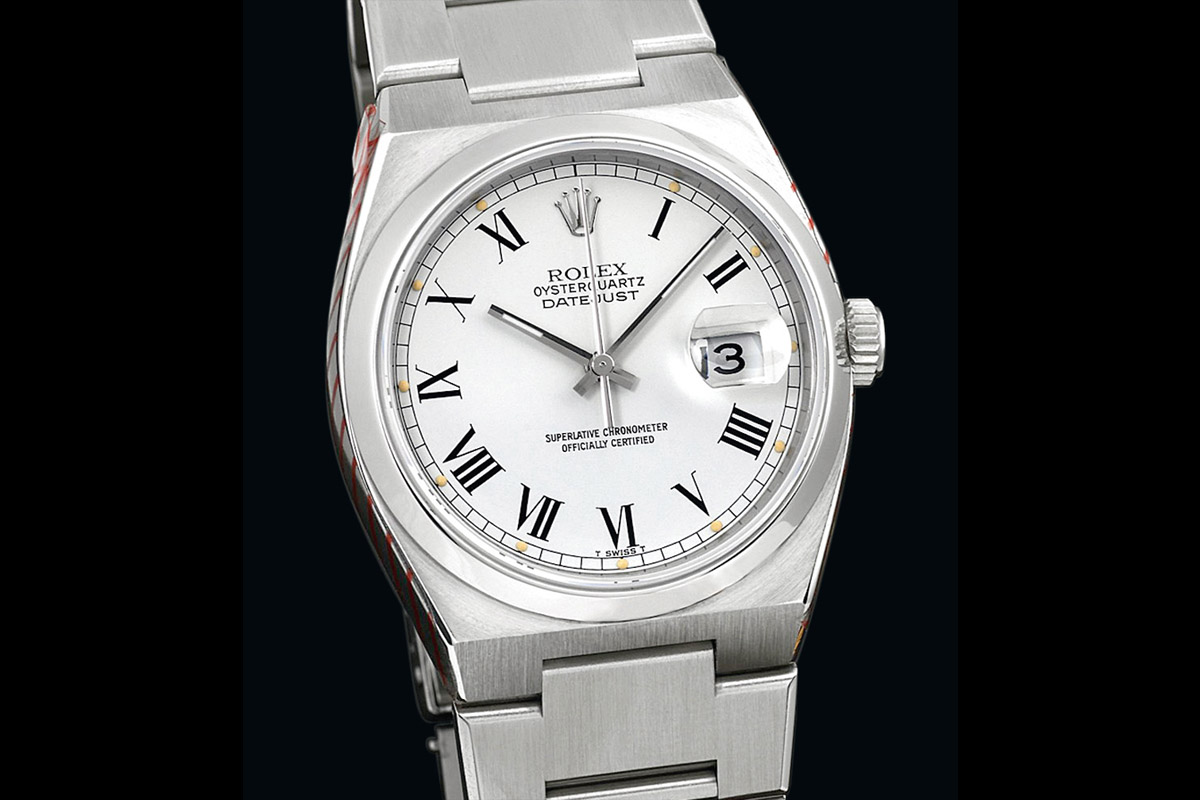
The Oyster Perpetual Datejust in steel or in steel with white gold bezel and Jubilee or Oyster bracelet ranks among the worth-stable classics. Watches from the 1970s and 1980s, with signs of use, are likely to be found under 2.000Eur. With used watches, one thing to control is the thickness of the lugs. After several polishing due to scratches, a lack of material should be seen as a real default and could set the price down. For later editions, supply of spare parts is secured. But there is huge probability that hands, dial or bracelet will be service one, yet another reason to set down the price required. Another thing to deeply control is the bracelet, as a lot of stretch can develop, especially with Jubilee bracelet. Replacement is very expensive, repairs are however possible, as well as the use of a leather strap that will fit well the Datejust too.
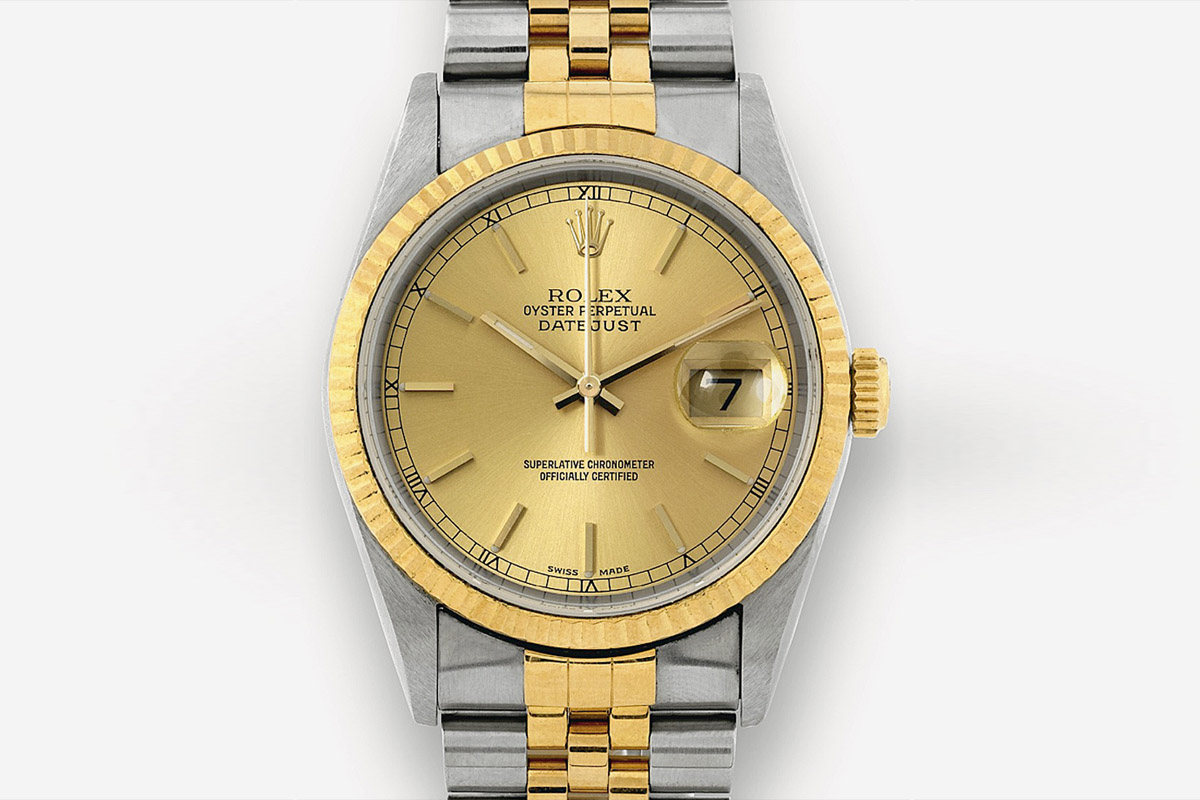
The expansive gold editions are clearly the less popular Datejust. Prices on the second-hand market start from 3.000Eur but can reach the 10.000Eur, however the condition of the watch and of the bracelet should be regarded extensively. Be careful also with aftermarket gem-settings, as Rolex won’t service those watches.
A timeless icon only slightly improved
A Datejust has a high recognition value, like almost all Rolex models. The shape of the case became more masculine within the years, but the rest of the watch (dial layout, hands, cyclops and specs) remained practically unchanged. Furthermore, the typical Jubilee or Oyster bracelets give the watch a timeless design. Only few special editions were ever available – one during the 1980s with a moonphase indication, and the Rolex Datejust Thunderbird with a rotating bezel. Beginning of the 2000s, Rolex introduced a new flat and polished bezel as an alternative to the fluted one. The size also remained constant over decades – up to the introduction of the current Datejust II, as it grew from 36 to 41 millimeters, an answer to the increasing demand for large sized watches. However this second edition of the Datejust remains elegant and close in its design to the basic Rolex Datejust.

The movements were also hugely improved, but not totally renewed. With the Calibre 3135, the Datejust enter the 21st century with its Parachrom Bleu spiral. In 2014, Rolex just introduced 3 new editions of the Datejust with coloured dials, proving once again the versatility and timeless spirit of this watch.
Constant improvements have created a unique watch: a reliable daily beater, highly accurate and suitable for every outfit.
This article was published first on WatchTime and republished here with authorization.












2 responses
but, is quality vintage Datejust better new rolex watch
No. They have constantly improved everything about their watches. But of course, so has everyone else! As for value for money, that was MUCH better 25, 30 years ago. They are 100% more expensive now than they should be.